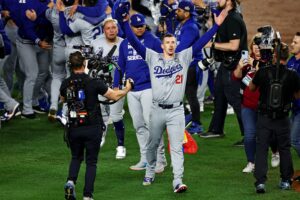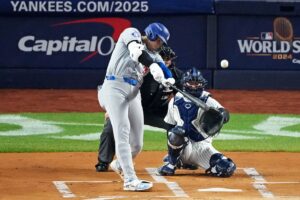The MLB Hall of Fame Case for PED Users
There is a debate in baseball that gains traction every year around the same time. After the MLB came cracking down on PED users in the mid-2000s, the league began to see many of the most prominent accused users began to retire. When those same users began to appear on MLB Hall Of Fame ballots, the public and the voters began to argue whether players should be voted in or not. The following is an individual breakdown of every accused user left on the ballot for 2021 and what their chances are.
Barry Bonds
1986-2007
-7x MVP
-762 HR (1st All-Time)
-2,558 BB (1st All-Time)
-668 IBB (1st All-Time)
Barry Bonds is the poster child for steroid use. He never failed a PED test, but his use was evident. The enlarged physique that he developed in the later 90s and his ludicrous, record-shattering numbers in the early 2000s all but seemed to stem from steroid use in hindsight. Entering the HOF ballot in 2013, Bonds received less than 50% until 2017 and has grown to 60% this year.
Bonds is on the ballot for two more years, which may be his saving grace considering his statistics and the lack of first-ballot players coming in 2021 and 2022. He does have the strongest case statically, but his personal dishonesty regarding his steroid use has skewed his career. Bonds may reach the hall in his final year on the ballot (a sort of punishment by the HOF voters), but there is always the possibility that they make him wait until the veteran’s committee as a form of discipline.
Roger Clemens
1984-2006
-7x Cy Young
-1986 AL MVP
-354 Wins (9th All-Time)
-4,672 Strikeouts (3rd All-Time)
-138.7 Pitching WAR (3rd All-Time)
Roger Clemens is extremely similar to Bonds. They were both arguably sure-fire Hall Of Famers before steroid use and put up some remarkable numbers in the years that they did use. Clemens also entered the ballot in 2013, and also did not receive 50% until 2017, and jumped to 61% this past voting. Clemens also has two more years remaining on the ballot, and will most likely either get in his last year on the ballot or wait until the veteran’s committee. Bonds and Clemens are the most renowned users on the ballot, with both of them having mixed opinions considering his HOF chances and his name being brought up in the Mitchell Report.
Gary Sheffield
1988-2009
-9x All-Star
-5x Silver Slugger
-509 Home Runs (26th All-Time)
-1,475 BB (21st All-Time)
Gary Sheffield is an interesting case. He, like Bonds and Clemens, was also mentioned in the Mitchell Report but lacks the “superstar” moniker that Bonds and Clemens developed, never winning an MVP award or setting single-season records. Sheffield thrived during the prime years of the steroid era in the late 90s and early 2000s, hitting 332 of his 509 career home runs between 1996 and 2005. His case is not as publicized as Bonds and Clemens, but his numbers prove that it is his steroid use that is keeping him out of the hall. 500 home runs is a benchmark for the hall of fame, with the only players with 500 home runs not in the hall being alleged PED users, active players, or have yet to be on the ballot.
Entering the ballot in 2015, Sheffield received less than 15% until this past year, receiving 30%. Sheffield may be in the same boat as Bonds and Clemens, having to wait until the last year on the ballot, or until the veteran’s committee. Having the advantage of being on the ballot for another four years.
Manny Ramirez
1993-2011
-555 HR (15th All-Time)
-.996 Career OPS (9th All-Time)
-1,831 Career RBI (19th All-Time)
In his prime, Manny Ramirez was just about as perfect a power hitter as the MLB had ever seen. From 1998 to 2006, Ramirez averaged (that’s right, averaged) 40 Home Runs, 127 RBIs, a .318 BA, and a 1.041 OPS with the Indians and after signing a huge deal with the Red Sox. Ramirez took his talents to the Red Sox on an eight-year, $160 million dollar contract. Two World Series rings later, Ramirez was traded to the Los Angeles Dodgers in 2008 and went on an absolute tear, now known as the “Mannywood” era, hitting .396 with 17 Home Runs, 53 RBIs, and a 1.232 OPS in 53 games down the stretch for the Dodgers. Ramirez was suspended 50 games in 2009 and his reputation was tarnished considerably, being suspended after the MLBs new drug policy. He did not produce much for the rest of his career and was out of the MLB by 2011.
Entering the HOF ballot in 2017, Ramirez received 28.3% of the vote in 2017, and less than 23% in 2018-19. After a jump to 28.2% in 2020, there’s a chance to get in on his final year of eligibility. Given the fact that Ramirez actually failed a drug test, he may not receive the same generosity. Ramirez has until 2026 to see his final chance.
Sammy Sosa
1989-2005, 2007
-1998 NL MVP
-609 Career HR (9th All-Time)
-Career Power-Speed #: 338.1 (12th All-Time)
Sammy Sosa gave hope to Chicago Cubs fans that hadn’t been felt in years. Sosa resurrected the bland Cubs to new heights with his memorable home run chase with Mark McGwire in 1998. Ending that season with 66 Home Runs, Sosa put himself second all-time for single-season home runs. Despite the 70 home runs that McGwire swatted that year, Sosa took home MVP award honors.
In 2013, Sosa entered the ballot to some unfavorable numbers. Sosa received 12.5%, 7.2%, 6.6%, 7.0%, 8.6%, 7.8%, and 8.5% from 2013 to 2019. An increase in 2020 shot his percentage to 13.9%. In his eighth year on the ballot, it’s unlikely he will get in on his last two years of eligibility.
Several stars of the steroid era, including Mark McGwire and Rafael Palmiero, have already seen themselves fall off the MLB Hall of Fame ballot. The next two years will see the direction of these players and where they end up. Will they have to wait until their final year on the ballot? Or will they have to wait until the veteran’s committee to see what their peers think of their accusations? Only time will tell, as it always does in baseball.






